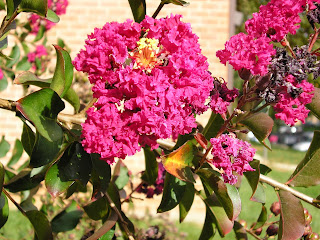Flowers and fruit on a crape myrtle (Lagerstroemia indica) on the northwest extension of Charter Oak Court. According to the Digital Atlas of Virginia Flora, crape myrtles do not grow in the wild in Virginia, but they are extensively cultivated, and with their bright pink, red, purple, and white flowers dominate the summer suburban landscape. See this page for a suggestion of the humongous variety of crape myrtle cultivars offered in the horticultural trade - there is no hope for me determining what particular cultivar is planted here at Charter Oak Court.
A closer view of the flower of this crape myrtle.
A close-up view of the crape myrtle fruit. We are toward the end of the long (2-3 months) flowering season for local crape myrtles, so most specimens now have more fruit than flowers on them.
Yet another example of fall-time chlorophyll degradation in the distal areas of a leaf producing a green vein pattern. These leaves, with their rounded lobes, clearly belong to a member of the white oak group (Quercus spp.), but not having seen an acorn, I cannot tell definitively whether this is a white oak (Quercus alba - see Virginia Tech fact sheet), an English oak (Quercus robur - see Virginia Tech fact sheet), or possibly another member of the group. This specimen is growing wild in the hedgerow that separates Hidden Creek Country Club from North Shore Drive just south of its intersection with Jonathan Way.
A Virginia creeper (Parthenocissus quinquefolia) vine climbing a young tree trunk in the same hedgerow. See the Virginia Tech fact sheet. This vine is very common in the Charter Oak Court area, although along the section of the W&OD trail that I frequent the dominant vine is wild grape rather than Virginia creeper. Both Virginia creeper and wild grape are native to the area, unlike kudzu, which I have not yet noticed here.
Close-up of a Virginia creeper leaf, showing it to be a palmately compound leaf composed of five serrated leaflets (hence the specific name quinquefolia, which is Latin for "five-leaved"). This readily distinguishes the Virginia creeper from wild grape, which has simple cordate (heart-shaped) leaves.







